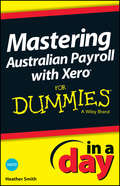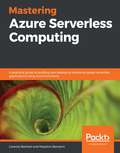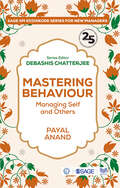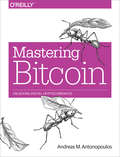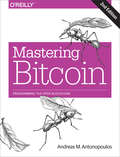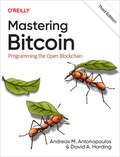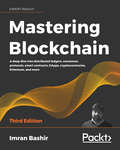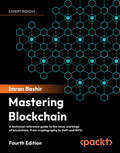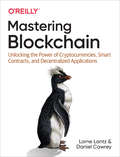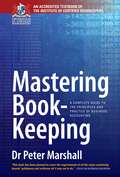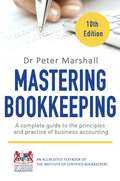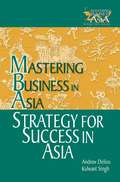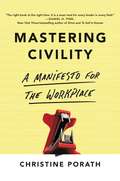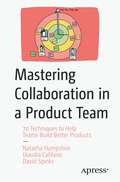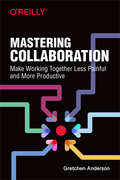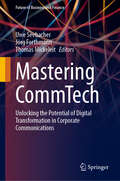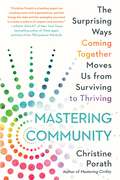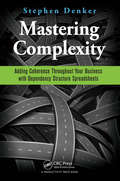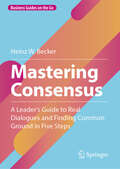- Table View
- List View
Mastering Australian Payroll with Xero In A Day For Dummies
by Heather SmithIf you’ve been using the cloud-based Xero system and running an existing payroll outside of Xero, or you’re looking to employ people for your small business in Australia, then this In A Day book is the resource you need. This book navigates through the payroll basics, and explains how to define payroll settings and set up employees. Mastering Australian Payroll with Xero In A Day For Dummies shows you how to define employee pay template settings, and helps you master some of the more advanced payroll functions in Xero. Employment expense is a significant chunk of outgoings for many businesses, so you want to make sure that you’ve covered all your bases, and that you’re meeting all of the relevant Australian compliance obligations. With this resource handy, you’ll be confidently processing payroll in Xero in no time — in fact, you’ll be there in just one day!
Mastering Azure Serverless Computing: A practical guide to building and deploying enterprise-grade serverless applications using Azure Functions
by Lorenzo Barbieri Massimo BonanniBecome an expert in implementing Azure Functions to work seamlessly with your serverless applications Key Features Develop scalable, robust multi-tier apps without worrying about infrastructure needs Deploy and manage cost-effective and highly available serverless apps using Azure Functions Accelerate enterprise-level application development by seamlessly integrating different cloud services with Azure Functions Book Description Application development has evolved from traditional monolithic app development to using serverless options and microservices. This book is designed to guide you through using Microsoft's Azure Functions to process data, integrate systems, and build simple APIs and microservices. You will discover how to apply serverless computing to speed up deployment and reduce downtime. You'll also explore Azure Functions, including its core functionalities and essential tools, along with understanding how to debug and even customize Azure Functions. In addition to this, the book will take you through how you can effectively implement DevOps and automation in your working environment. Toward the concluding chapters, you'll cover some quick tips, troubleshooting techniques, and real-world serverless use cases that will help you make the most of serverless computing. By the end of this book, you will have gained the skills you need to develop and deliver cost-effective Azure serverless solutions. What you will learn Create and deploy advanced Azure Functions Learn to extend the runtime of Azure Functions Orchestrate your logic through code or a visual workflow Add caching, security, routing, and filtering to your APIs Use serverless technologies in real-world scenarios Understand how to apply DevOps and automation to your working environment Who this book is for This book is designed for cloud administrators, architects, and developers interested in building scalable systems and deploying serverless applications with Azure Functions. Prior knowledge of core Microsoft Azure services and Azure Functions is necessary to understand the topics covered in this book.
Mastering Behaviour: Managing Self and Others (SAGE IIM Kozhikode Series for New Managers)
by Payal AnandA new workplace demands that you take charge of your anchors. It challenges you to pay attention to the aspects that drive your behaviour, attitudes, perceptions, and emotions. At the same time, recognizing the motives, needs and emotions of others is imperative for personal leadership. This will help you hone your collaborative instincts, and in embracing diversity and engaging effectively in a professional setting. Based on the author’s experiences and her interaction with others, Mastering Behaviour explores the hinterland of behavioural insights. Applying popular psychology theories, the book helps in tackling difficult interpersonal and behavioural issues at work, such as personality clashes, stress, handling difficult interactions and workplace loneliness. With technological developments changing the way we connect, the book will provide insights to the real-world challenges of developing greater trust, engagement and collaboration within their teams and the organization.
Mastering Bitcoin
by Andreas M. AntonopoulosWant to join the technological revolution that's taking the world of finance by storm? Mastering Bitcoin is your guide through the seemingly complex world of bitcoin, providing the requisite knowledge to help you participate in the internet of money. Whether you're building the next killer app, investing in a startup, or simply curious about the technology, this practical book is essential reading.Bitcoin, the first successful decentralized digital currency, is still in its infancy and it's already spawned a multi-billion dollar global economy. This economy is open to anyone with the knowledge and passion to participate. Mastering Bitcoin provides you with the knowledge you need (passion not included).This book includes:A broad introduction to bitcoin--ideal for non-technical users, investors, and business executivesAn explanation of the technical foundations of bitcoin and cryptographic currencies for developers, engineers, and software and systems architectsDetails of the bitcoin decentralized network, peer-to-peer architecture, transaction lifecycle, and security principlesOffshoots of the bitcoin and blockchain inventions, including alternative chains, currencies, and applicationsUser stories, analogies, examples, and code snippets illustrating key technical concepts
Mastering Bitcoin: Programming the Open Blockchain
by Andreas M. AntonopoulosJoin the technological revolution that’s taking the financial world by storm. Mastering Bitcoin is your guide through the seemingly complex world of bitcoin, providing the knowledge you need to participate in the internet of money. Whether you’re building the next killer app, investing in a startup, or simply curious about the technology, this revised and expanded second edition provides essential detail to get you started.Bitcoin, the first successful decentralized digital currency, is still in its early stages and yet it’s already spawned a multi-billion-dollar global economy open to anyone with the knowledge and passion to participate. Mastering Bitcoin provides the knowledge. You simply supply the passion.The second edition includes:A broad introduction of bitcoin and its underlying blockchain—ideal for non-technical users, investors, and business executivesAn explanation of the technical foundations of bitcoin and cryptographic currencies for developers, engineers, and software and systems architectsDetails of the bitcoin decentralized network, peer-to-peer architecture, transaction lifecycle, and security principlesNew developments such as Segregated Witness, Payment Channels, and Lightning NetworkA deep dive into blockchain applications, including how to combine the building blocks offered by this platform into higher-level applicationsUser stories, analogies, examples, and code snippets illustrating key technical concepts
Mastering Bitcoin: Programming the Open Blockchain
by Andreas M. Antonopoulos David A. HardingJoin the technological revolution that's taking the financial world by storm. Mastering Bitcoin is your guide through the seemingly complex world of Bitcoin, providing the knowledge you need to participate in the internet of money. Whether you're building the next killer app, investing in a startup, or simply curious about the technology, this revised and expanded third edition provides essential detail to get you started. Bitcoin, the first successful decentralized digital currency, has already spawned a multibillion-dollar global economy open to anyone with the knowledge and passion to participate. Mastering Bitcoin provides the knowledge. You supply the passion.The third edition includes:A broad introduction to Bitcoin and its underlying blockchain—ideal for nontechnical users, investors, and business executivesAn explanation of Bitcoin's technical foundation and cryptographic currency for developers, engineers, and software and systems architectsDetails of the Bitcoin decentralized network, peer-to-peer architecture, transaction lifecycle, and security principlesNew developments such as Taproot, Tapscript, Schnorr signatures, and the Lightning NetworkA deep dive into Bitcoin applications, including how to combine the building blocks offered by this platform into powerful new toolsUser stories, analogies, examples, and code snippets illustrating key technical concepts
Mastering Blockchain: A deep dive into distributed ledgers, consensus protocols, smart contracts, DApps, cryptocurrencies, Ethereum, and more, 3rd Edition
by Imran BashirDevelop a deep understanding of the theoretical foundations of blockchain technology and learn how to write smart contracts and build decentralized applications Key Features Updated with four new chapters on consensus algorithms, Ethereum 2.0, tokenization, and enterprise blockchains Dive deep into foundational pillars of blockchain technology such as decentralization, cryptography, and consensus protocols Get to grips with Solidity, Web3, cryptocurrencies, smart contract development and solve scalability, security, and privacy issues Discover the architecture of different distributed ledger platforms including Ethereum, Bitcoin, Hyperledger Fabric, Hyperledger Sawtooth, Corda, and Quorum Book Description Blockchain technology is the backbone of cryptocurrencies, and it has applications in finance, government, media, and many other industries. With a legacy of providing technologists with executable insights, the third edition of Mastering Blockchain is thoroughly revised and updated with the latest blockchain research, including four new chapters on consensus algorithms, Serenity (Ethereum 2.0), tokenization, and enterprise blockchains. Apart from covering the basics, including blockchain's technical underpinnings, cryptography, and consensus protocols, this book provides you with expert knowledge on decentralization, decentralized application development on Ethereum, Bitcoin, alternative coins, smart contracts, alternative blockchains, and Hyperledger. Furthermore, you will explore how to implement blockchain solutions beyond cryptocurrencies, such as the Internet of Things with blockchain, blockchain scalability, enterprise blockchains, and tokenization using blockchain, and the future scope of this fascinating and disruptive technology. By the end of this book, you will have gained a thorough understanding of the various facets of blockchain technology and be comfortable applying them to diverse real-world scenarios. What you will learn Grasp the mechanisms behind Bitcoin, Ethereum, and alternative cryptocurrencies Understand cryptography and its usage in blockchain technology Understand the theoretical foundations of smart contracts Develop decentralized applications using Solidity, Remix, Truffle, Ganache, and Drizzle Identify and examine applications of blockchain beyond cryptocurrencies Understand the architecture and development of Ethereum 2.0 Explore research topics and the future scope of blockchain technology Who this book is for If you are a technologist, business executive, a student or an enthusiast who wishes to explore the fascinating world of blockchain technology, smart contracts, decentralized applications and distributed systems then this book is for you. Basic familiarity with a beginner-level command of a programming language would be a plus.
Mastering Blockchain: A technical reference guide to the inner workings of blockchain, from cryptography to DeFi and NFTs, 4th Edition
by Imran BashirDemystify one of the most disruptive modern technologies and gain an understanding of distributed ledger technology, consensus protocols, smart contracts, DApps, blockchain scalability, privacy, security, and more.Purchase of the print or Kindle book includes a free eBook in PDF format.Key FeaturesStudy new blockchains, including Polkadot, Solana, and dive into the architecture of Ethereum's execution and consensus layerExplore distributed ledger technologies such as Ethereum, Bitcoin, Hyperledger Fabric, and QuorumGet to grips with Solidity, Web3, NFTs, DeFi, and smart contract developmentBook DescriptionBlockchain is the backbone of cryptocurrencies, with applications in finance, government, media, and more. With a legacy of providing technologists with executable insights, this new edition of Mastering Blockchain is thoroughly revised and updated according to the latest blockchain research. With new chapters on decentralized finance, decentralized identity, blockchain privacy, scalability, security, and bonus online content exploring alternative blockchains, this is an unmissable read for everyone who wants to gain a deep understanding of blockchain.Although this book covers the basics, including blockchain's technical underpinnings, cryptography, and consensus protocols, it doesn't shy away from advanced topics and practical expertise, such as decentralized application (DApp) development using smart contracts. Throughout the book, you'll explore blockchain solutions beyond cryptocurrencies, such as the Internet of Things (IoT) with blockchain, enterprise blockchains, and tokenization, and gain insight into the future scope of this fascinating and disruptive technology.By the end of this blockchain book, you will have gained a thorough understanding of the various facets of blockchain and understand the potential of this technology in diverse real-world scenarios.What you will learnGrasp the mechanisms behind Bitcoin, Ethereum, and other blockchain protocolsUnderstand cryptography and its usage in blockchainBecome familiar with blockchain consensus algorithms and develop smart contracts and DApps using Solidity, Remix, Truffle, and GanacheSolve issues relating to scalability, privacy, and security in blockchainExplore enterprise blockchainsDelve into emerging trends like decentralized and self-sovereign identity, DeFi, NFTs, and MetaverseExplore various applications, research topics, and future directions of blockchainWho this book is forThis book is for blockchain enthusiasts from all backgrounds, including business executives who want to leverage new platforms and students who want to a textbook exploring this fascinating technology. It is also a useful reference guide for blockchain development professionals who want to build fast and highly secure transactional applications. Basic knowledge in any programming language will come in handy.
Mastering Blockchain: Unlocking The Power Of Cryptocurrencies, Smart Contracts, And Decentralized Applications
by Lorne Lantz Daniel CawreyThe future will be increasingly distributed. As the publicity surrounding Bitcoin and blockchain has shown, distributed technology and business models are gaining popularity. Yet the disruptive potential of this technology is often obscured by hype and misconception. This detailed guide distills the complex, fast moving ideas behind blockchain into an easily digestible reference manual, showing what's really going on under the hood.Finance and technology pros will learn how a blockchain works as they explore the evolution and current state of the technology, including the functions of cryptocurrencies and smart contracts. This book is for anyone evaluating whether to invest time in the cryptocurrency and blockchain industry. Go beyond buzzwords and see what the technology really has to offer.Learn why Bitcoin was fundamentally important in blockchain's birthLearn how Ethereum has created a fertile ground for new innovations like Decentralized Finance (DeFi), Non-Fungible Tokens (NFTs) and Flash LoansDiscover the secrets behind cryptocurrency prices and different forces that affect the highly volatile cryptocurrency marketsLearn how cryptocurrencies are used by criminals to carry out nefarious activitiesDiscover how enterprise and governments are leveraging the blockchain including FacebookUnderstand the challenges of scaling and forking a blockchainLearn how different blockchains workLearn the language of blockchain as industry terms are explained
Mastering Book-Keeping
by Dr. Peter MarshallDouble-entry accounting can be easy if it's explained well, and Mastering Book-keeping does just that. Now in its updated 8th edition, this popular book has helped thousands of people to get to grips with book-keeping. It explains the principles and practice of book-keeping sequentially, and includes: - The daybooks and ledger accounts - End of year accounting - Sole proprietorships, limited companies, partnerships and not-for-profit organisations - Using computers for accounting - Accounting for VAT - Progressing to more advanced management accounting - The implications of the Data Protection Act 1998 on book-keepers Plus step-by-step guides to compiling a balance sheet, depreciation, accounting for bad and doubtful debts, and much more. Everything is made clear with easy-to-follow explanations. Typical transactions are illustrated throughout to make the information even easier to understand. This book is suitable for those preparing for the examinations of ICB, AAT, IAB, OCR, AQA and all other courses in book-keeping and accounts.
Mastering Book-Keeping: A Complete Guide To The Principles And Practice Of Business Accounting (Small Business Ser.)
by Peter MarshallDouble-entry accounting can be easy if it's explained well, and Mastering Book-keeping does just that. Now in its updated 8th edition, this popular book has helped thousands of people to get to grips with book-keeping. It explains the principles and practice of book-keeping sequentially, and includes: - The daybooks and ledger accounts - End of year accounting - Sole proprietorships, limited companies, partnerships and not-for-profit organisations - Using computers for accounting - Accounting for VAT - Progressing to more advanced management accounting - The implications of the Data Protection Act 1998 on book-keepers Plus step-by-step guides to compiling a balance sheet, depreciation, accounting for bad and doubtful debts, and much more. Everything is made clear with easy-to-follow explanations. Typical transactions are illustrated throughout to make the information even easier to understand. This book is suitable for those preparing for the examinations of ICB, AAT, IAB, OCR, AQA and all other courses in book-keeping and accounts.
Mastering Bookkeeping, 10th Edition: A complete guide to the principles and practice of business accounting
by Dr. Peter MarshallThe book explains the principles and practice of bookkeeping sequentially, including:·The bank reconciliation·Writing up the petty cash book·Extracting a trial balance·Accruals and prepayments·Setting up a limited company·Accounting for VATPlus step-by-step guides to compiling a balance sheet, depreciation, accounting for bad and doubtful debts and much more.The 10th edition also includes significant enhancements to reflect the teachings of the principle bookkeeping institutes as they endeavour to raise the professional competence of their members. For example, accounting staff are increasingly being required to extend their record keeping into management accounts areas. The new edition includes chapters on stock control and budgetary control accounting. In addition, it will include more detailed guidance on the significance and importance of ratio analysis and statements of sources and application of funds, plus the latest available IAB and ICB exam papers.
Mastering Bookkeeping, 10th Edition: A complete guide to the principles and practice of business accounting
by Peter MarshallThe book explains the principles and practice of bookkeeping sequentially, including:·The bank reconciliation·Writing up the petty cash book·Extracting a trial balance·Accruals and prepayments·Setting up a limited company·Accounting for VATPlus step-by-step guides to compiling a balance sheet, depreciation, accounting for bad and doubtful debts and much more.The 10th edition also includes significant enhancements to reflect the teachings of the principle bookkeeping institutes as they endeavour to raise the professional competence of their members. For example, accounting staff are increasingly being required to extend their record keeping into management accounts areas. The new edition includes chapters on stock control and budgetary control accounting. In addition, it will include more detailed guidance on the significance and importance of ratio analysis and statements of sources and application of funds, plus the latest available IAB and ICB exam papers.
Mastering Business Intelligence with MicroStrategy
by Ning Ma Dmitry Anoshin Himani RanaBuild world-class enterprise Business Intelligence solutions with MicroStrategy 10 About This Book * Fix the gap between BI tools and implementation/integration processes with big data and predictive analytics using this comprehensive guide to MicroStrategy 10 * Highly practical, example-rich guide that lets you implement business intelligence with MicroStrategy 10 in your organization * Create the best user experience with BI dashboards using MicroStrategy using this up-to-date, comprehensive guide Who This Book Is For This book is intended for BI, DWH, ETL developers, BI/DWH/Analytics managers, analysts, and business users who already have MicroStrategy in their organization and want to take it to the next level in order to increase performance and improve user experience. In addition, it helps the reader to migrate from MicroStrategy 9 to MicroStrategy 10 and to start using the new capabilities. What You Will Learn * Explore various visualization techniques for presenting analyzed data * Customize MicroStrategy in order to meet your business requirements * Develop and design mobile dashboards * Use the advanced techniques such as designing reports, documents and interactive dashboards for building dashboards * Understand the concepts of data discovery and Desktop capabilities * Explore the best practices for Microstrategy system administration * Find and fix issues based on connections, environment or documents * Integrate third party ESRI map tools with MicroStrategy to create geo based reports In Detail Business intelligence is becoming more important by the day, with cloud offerings and mobile devices gaining wider acceptance and achieving better market penetration. MicroStrategy Reporting Suite is an absolute leader in the BI market and offers rich capabilities from basic data visualizations to predictive analytics. It lets you various delivery methods such as the Web, desktops, and mobiles. Using real-world BI scenarios, this book helps you to implement Business Analytics solutions in big e-commerce companies. It kicks off with MicroStrategy 10 features and then covers schema design models and techniques. Building upon your existing knowledge, the book will teach you advanced techniques for building documents and dashboards. It further teaches various graphical techniques for presenting data for analysis using maps, graphs, and advanced charts. Although MicroStrategy has rich functionality, the book will show how to customize it in order to meet your business requirements. You will also become familiar with the native analytical functions that will help you to maximize the impact of BI solutions with powerful predictive analytics. Furthermore, the book will focus on MicroStrategy Mobile Analytics along with data discovery and desktop capabilities such as connecting various data sources and building interactive dashboards. The book will also uncover best practices, troubleshooting techniques for MicroStrategy system administration, and also security and authentication techniques. Lastly, you will learn to use Hadoop for MicroStrategy reporting. By the end of the book, you will become proficient in evaluating any BI software in order to choose the best one that meets all business requirements. Style and approach This book will be focusing on providing extensive guide to plan how to design and develop complex BI architecture for real world scenario, using Microstrategy 10, best practices and collected experience working with BI, predictive analytics, and Microstrategy and big data.
Mastering Business Negotiation
by Roy J. Lewicki Alexander HiamMastering Business Negotiation is a handy resource for any leader or manager who needs practical strategies and ideas when conducting business negotiations. Grounded in solid research, the authors - experts in the field of business negotiation - reduce the huge volume of available information into an accessible handbook for busy executives who need to prepare for everyday negotiations as well as for more demanding and complex negotiation situations.Mastering Business Negotiation offers down-to-earth advice for learning to play the negotiation game and shows how to:Understand the game so you can better control what happensPredict the sequence of negotiation activities and move from disagreement toward agreementIdentify the strategies and tactics of other players in the game.Apply the rules of the game - the "do's and don'ts" that will ultimately lead to success
Mastering Business in Asia
by Kulwant Singh Andrew DeliosIn order to achieve success, managers need to understand the strategic issues in Asia. Strategy for Success in Asia covers areas from the uniqueness of Asia like its economic and cultural diversity to the roles of governments and the importance of alliances. One of the first books to offer a perspective effective company strategy and how local and multinational companies can achieve strategic success in Asia. This important book is for anyone who has a stake in Asia or has plans to do business in it.
Mastering Civility: A Manifesto for the Workplace
by Christine PorathFrom the leading authority on workplace incivility, Christine Porath, shows why it pays to be civil, and reveals just how to enhance effectiveness in the workplace and beyond by mastering civility.Incivility is silently chipping away at people, organizations, and our economy. Slights, insensitivities, and rude behaviors can cut deeply and hijack focus. Even if people want to perform well, they can't. Ultimately incivility cuts the bottom line.In MASTERING CIVILITY, Christine Porath shows how people can enhance their influence and effectiveness with civility. Combining scientific research with fascinating evidence from popular culture and fields such as neuroscience, medicine, and psychology, this book provides managers and employers with a much-needed wake-up call, while also reminding them of what they can do right now to improve the quality of their workplaces.
Mastering Collaboration in a Product Team: 70 Techniques to Help Teams Build Better Products
by David Spinks Glaudia Califano Natasha HampshireThe nature of product development is changing. The most successful innovations are those that come from teams of people who are exploring problems together. Teams that build meaningful releases of their products iteratively and incrementally are opening the door for early feedback so that decisions can be taken to persevere or pivot based on evidence. But how do you make the most out of a team’s different perspectives, experiences and ideas? How can you instill a collaborative mindset in a product development team? How do you find out if your product idea actually has any value? How can you truly understand people’s needs? Mastering Collaboration in a Product Team is a toolbox of proven techniques from the field for the whole product team to use together to find answers to these questions and more. It is filled with practical tools to maximize your team’s chances of success when developing products and services, from identifying opportunities, to the point of being able to confidently go into production.What You'll LearnDefine people’s real problems and needsCollaboratively create innovative ideasValidate product/feature ideas quickly and cheaply as a teamExplore a lightweight introduction to the techniques of modern product developmentWho This Book Is ForProduct Owners, Product Managers, Business Analysts, Development Team Members, Designers, Scrum Masters, Agile Coaches or anyone in a role responsible for designing, developing, or sustaining products or services, with the purpose of maximizing their value.
Mastering Collaboration: Make Working Together Less Painful and More Productive
by Gretchen AndersonCollaboration is key for organizations in the 21st century, yet few business people have been trained to teach this skill. How do you advance ideas in a collaborative way and then communicate them throughout your company? In this practical book, author Gretchen Anderson shows you how to generate ideas with others while gaining buy-in from all levels of your organization.Product managers, designers, marketers, technical leaders, and executives will obtain better insight into how team members work together to make decisions. Through tangible exercises and techniques, you’ll learn how to turn promising ideas into products, services, and solutions that make a real difference in the market.Use a framework to develop ideas into hypotheses to be tested and refinedAvoid common pitfalls in the collaboration processAlign communication approaches to ensure that collaboration is effective and inclusiveStructure events or meetings for different types of collaboration depending on the people involvedPractice giving and receiving critiques to foster inclusion without resorting to consensus-based decisions
Mastering CommTech: Unlocking the Potential of Digital Transformation in Corporate Communications (Future of Business and Finance)
by Uwe Seebacher Thomas Mickeleit Jörg ForthmannThis edited collection by over 30 industry experts and scholars explores how communication departments can digitize processes to continue contributing to their companies' success. It deals with key questions such as the necessity of digitalizing corporate communication, optimal data for success, KPI reporting solutions, and the role of data storytelling and artificial intelligence. Additionally, it covers future-relevant roles and skills, essential tools and trends, and crucial aspects of upcoming technologies that promise to change the world of corporate communications. A must-read for practitioners at all levels, this book serves as a reference for keen MBA graduates and journalists who are keen to explore corporate communications as a future career option.
Mastering Communication at Work: How to Lead, Manage, and Influence
by Jon Wortmann Ethan F. BeckerMastering Communication at Work provides clear, actionable advice you can put to use right away and simple drills to practice during your next meeting, one-on-one conversation--or even sitting at your desk.
Mastering Community: The Surprising Ways Coming Together Moves Us from Surviving to Thriving
by Christine PorathFrom the author of Mastering Civility, a thoroughly researched exploration of the impact and importance of building thriving communities, with actionable steps on how to create them in your work and broader life.In her powerful new book, Christine Porath explores how the rise of technology and modern workplace practices have fractured our communications yet left us always &“on&” digitally. Through now common practices like hot-desking and remote work (even without the added isolation of social distancing we experienced during the pandemic), our human interactions have decreased, and so too have our happiness levels. This lack of a &“human factor&” is sparking a crisis in mental health that will have repercussions for years to come, leaving people lonelier and making the bottom line suffer, too. What Christine has discovered in her research is that leaders, organizations, and managers of all stripes may recognize there is a cost, but have no idea as to implement the cure: Community. With her signature depth and grasp of research across myriad industries including business, healthcare, hospitality, and sports, Christine extrapolates from the statistics on the experiences of hundreds of thousands of people across six continents to show us the potential for change. Through sharing information about the community, empowering decision-making discretion and autonomy, creating a respectful environment, offering feedback, providing a sense of meaning, and boosting member well-being, anyone can help a community truly flourish. The applications are endless, the stories are positive and uplifting, and will inspire the reader to establish and grow their community—be it in the workplace or the PTA—and make it thrive.
Mastering Complexity: Adding Coherence Throughout Your Business with Dependency Structure Spreadsheets
by Stephen DenkerMastering Complexity is designed to help readers develop and maintain logical, adaptable solutions to business problems. It demonstrates how to visualize business dependency connections with a square spreadsheet called a Dependency Structure Matrix (DSM). Once the links representing dependencies are visualized in a DSM, it can be used to improve th
Mastering Consensus: A Leader's Guide to Real Dialogues and Finding Common Ground in Five Steps (Business Guides on the Go)
by Heinz W. BeckerAchieving a common purpose begins with diverse ideas and opinions. This book guides managers through a five-step process to transform productive controversy into unified action. Mastering these steps helps managers stay grounded and effective, even in turbulent times. Learn to handle difficult candidates, manage rivalry and hierarchy, and navigate chaotic discussions. The author introduces innovative concepts on hierarchy, authority, and leadership styles. The message of the book emphasizes recognizing and using “magic moments” in discussions and promoting good will without imposing values. The steps provided in the book help unlock the secrets to effective consensus-building and leadership with practical strategies and insights. This book is essential for managers seeking to foster collaboration and drive successful outcomes.
Mastering Consultation as an HR Practitioner: Making an Impact in Small Business (Making an Impact in Small Business HR)
by Jennifer CurrenceHR professionals are uniquely positioned to lead transformation, but doing so requires a consultative mindset. Mastering Consultation as an HR Practitioner equips HR professionals with tools and frameworks to advise leaders, define organizational needs, and implement lasting change. This practical guide offers best practices for data gathering, problem-solving and solution development, all grounded in a consultative approach. Featuring real-world case studies, worksheets and ready-to-use resources, it helps practitioners apply strategic thinking to everyday challenges and elevate their value within the organization.Whether you're supporting a business unit or driving company-wide initiatives, this book shows how to build trust, influence outcomes and lead with impact.
